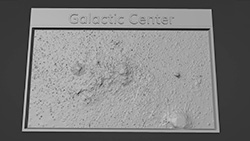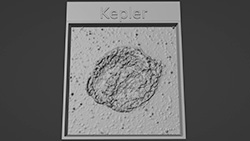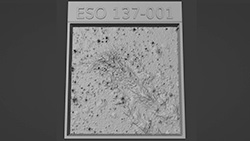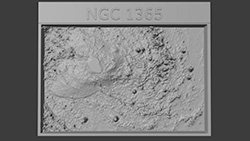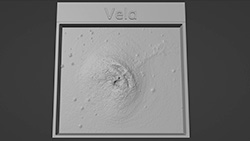CXC Home | Search | Help | Image Use Policy | Latest Images | Privacy | Accessibility | Glossary | Q&A
1
X-ray, Infrared, & Optical ImagesCredit: NASA/CXC/SAO, JPL-Caltech, MSFC, STScI, ESA/CSA, SDSS, ESO
Five new images feature X-ray data from Chandra along with other types of light from different telescopes, including NASA's Webb, Hubble and IXPE telescopes. The objects range both in distance and category. Vela and Kepler are supernova remnants within our own Milky Way galaxy, the center of which can be seen in the top panorama. NGC 1365 is a double-barred spiral galaxy located about 60 million light-years from Earth. Farther away and on an even larger scale, ESO 137-001 shows what happens when a galaxy hurtles through space and leaves a wake behind it.
2
3D Printable Tactile Plates This release features five separate tactile plates of cosmic entities, made from data captured in different kinds of light.
The first plate in the collection is the Galactic Center from NASA’s Chandra X-ray Observatory. Here, the busy and active center of our Milky Way galaxy resembles a cloud, dotted with several orbs of light. Surrounding the cloud is a dense field of specks that entirely blankets the sky. In this plate, all raised areas represent X-ray light from Chandra.
The second plate features Kepler's Supernova Remnant, the remains of a white dwarf star that was destroyed by a thermonuclear explosion. The image plate represents X-ray light from Chandra, optical light from the Hubble Space Telescope and infrared light from the Spitzer Space Telescope. The remnant resembles a knotted ball of crackling energy, set against a sparse sky dotted with specks. Streaks and patches of mottled texture represent debris from the destroyed star. A web of veins encircles and weaves through the knot, representing the powerful blast wave captured by Chandra.
In the third plate, a bump of light encircled by subtle swirls rockets toward our upper left, leaving two, long, streaming tails behind it. This is ESO 137-001, a galaxy moving through space at 1.5 million miles per hour. Set against a background packed with pointy stars, the galaxy's twin tails feature streams of raised material floating inside superheated gas. Clusters of dots, hydrogen atoms, seem to travel with the galaxy, alongside the flowing tails. The object depicts X-ray light collected from Chandra, light from hydrogen atoms from ESO’s Very Large Telescope, and optical and infrared light from Hubble.
The fourth plate features a close-up of the spiral galaxy NGC 1365, and the supermassive black hole at its center. The galaxy is shown at a dramatic angle, as if the raised plateau of a core is gazing past our right shoulder. Swirls of material, resembling waves in a dark ocean, spiral toward the core, which hangs at our upper left. Spiraling circles, and flecks dot the churning spiral galaxy. In this plate, Chandra X-ray data has been combined with infrared data from NASA’s James Webb Space Telescope.
The fifth plate of this release features the Vela Pulsar, the aftermath of a collapsed and exploded star sending a jet of particles into space. The pulsar resembles a soft, pillowy, bean in a pocket of gas. A faint stream of gas, the X-ray jet, seems to shoot from the pocket, heading into the distance at our upper right. Raised markings in the bean shape suggest narrow eyes and an open mouth, giving the pulsar a squinting happy face. The tactile plate combines data from NASA’s Imaging X-ray Polarimetry Explorer, Chandra, and Hubble.
Galactic Center Tactile Plate
(3D Print Credit: NASA/CXC/A. Jubett & K.Arcand, using software by Tactile Universe/N. Bonne & C. Krawczyk & Blender)
(3D Print Credit: NASA/CXC/A. Jubett & K.Arcand, using software by Tactile Universe/N. Bonne & C. Krawczyk & Blender)
Kepler's Supernova Remnant Tactile Plate
(3D Print Credit: NASA/CXC/A. Jubett & K.Arcand, using software by Tactile Universe/N. Bonne & C. Krawczyk & Blender)
(3D Print Credit: NASA/CXC/A. Jubett & K.Arcand, using software by Tactile Universe/N. Bonne & C. Krawczyk & Blender)
ESO 137-001 Tactile Plate
(3D Print Credit: NASA/CXC/A. Jubett & K.Arcand, using software by Tactile Universe/N. Bonne & C. Krawczyk & Blender)
(3D Print Credit: NASA/CXC/A. Jubett & K.Arcand, using software by Tactile Universe/N. Bonne & C. Krawczyk & Blender)
NGC 1365 Tactile Plate
(3D Print Credit: NASA/CXC/A. Jubett & K.Arcand, using software by Tactile Universe/N. Bonne & C. Krawczyk & Blender)
(3D Print Credit: NASA/CXC/A. Jubett & K.Arcand, using software by Tactile Universe/N. Bonne & C. Krawczyk & Blender)
Vela Pulsar
(3D Print Credit: NASA/CXC/A. Jubett & K.Arcand, using software by Tactile Universe/N. Bonne & C. Krawczyk & Blender)
(3D Print Credit: NASA/CXC/A. Jubett & K.Arcand, using software by Tactile Universe/N. Bonne & C. Krawczyk & Blender)
Return to A Fab Five: New Images With NASA's Chandra X-ray Observatory (September 13, 2023)






















